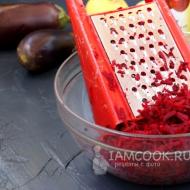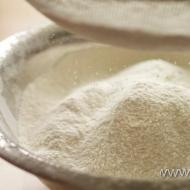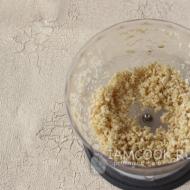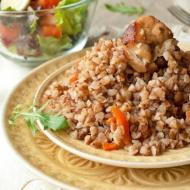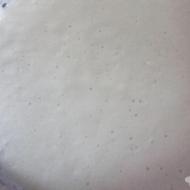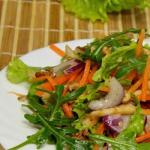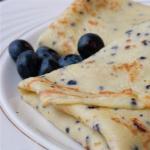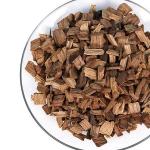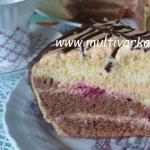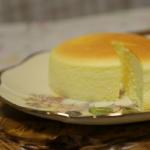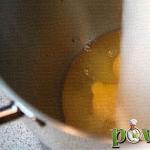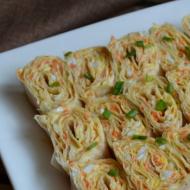
The simplest Easter cake with cottage cheese. Easter cottage cheese cake made with soda. Step-by-step cooking recipe
Easter is just around the corner, we just have to wait a little longer. Many of us want to prepare as much as possible for this holiday, paint eggs and even bake Easter cake ourselves. It’s true that you don’t always have enough free time to cook a classic Easter cake with yeast. But don’t worry, for those who have little time or experience, cottage cheese Easter cake is perfect for Easter, which is prepared much faster and does not even require the use of yeast, long tedious preparation and wasted nerves if something didn’t turn out quite as planned .
The curd cake tastes wonderful and tender. Unlike the classic one, it turns out to be more biscuit-like. Especially if the recipe uses a lot of eggs, then the Easter cake dough may seem more suitable for a pie or even a cake. But it’s worth adding candied fruits and raisins to it, pouring over the finished Easter cake, and you’ll remember the holiday for a long time.
I think this recipe is an excellent alternative to labor-intensive yeast cakes, which unfortunately not all of us have the opportunity to prepare. Some have small children, others have a lot of work. We shouldn’t be left without a holiday because of this.
Cottage cheese cake with orange juice - a delicious recipe for Easter
Sweet, tender and airy like a cupcake - this is a wonderful cottage cheese cake that we will prepare. For Easter cake we use a lot of candied fruits and raisins to diversify its “inner world”. You will definitely like the result. Stock up on cake pans in advance or use a tall muffin pan if you have one at home.
You will need:
- flour - 300 gr,
- cottage cheese 9% - 125 g,
- butter - 125 g,
- egg - 1 piece,
- baking powder - 10 g,
- zest of 1 orange,
- orange juice (fresh) - 50 g,
- candied fruits - 70 g,
- raisins - 50 gr,
- nuts - 50 gr,
- vanillin - 1 g,
- salt - 0.5 teaspoon.
Preparation:
1. Let's start preparing cottage cheese cake with its most important ingredient - cottage cheese. Take a small bowl and grind the cottage cheese with a blender until it becomes homogeneous and all the grains are ground. For Easter cake it is best to use delicious fatty cottage cheese, but in any case the choice is yours.

2. In another bowl, heat the butter until it softens. Add granulated sugar to the bowl and beat them together using a mixer. The mass should become fluffy and tender, like cream, and the sugar should dissolve.

3. Break one egg there and continue beating until the egg is completely mixed.

4. The next thing we add to the same mass is cottage cheese. It is already soft and will easily mix with butter and egg. We continue to do everything with a mixer.

5. Now take a fresh orange and wash it thoroughly. Grate the zest from the peel using a special zester or grater. Place the finished aromatic zest in a bowl where you beat the mixture. Pour freshly squeezed orange juice in there. Squeeze it out of the orange yourself; it’s better not to take store-bought juice.

6. In a separate bowl, mix the dry ingredients. Sift the flour, add baking powder, vanillin and salt. Mix everything thoroughly with a whisk or spoon so that the baking powder is evenly distributed.

7. Now connect both parts of the future dough. Knead the dry and liquid ingredients in one bowl using a spoon or spatula into a thick and dense dough. Stir until it becomes completely homogeneous and all the lumps of flour disappear.

8. Add raisins, candied fruits and nuts to the resulting dough. Don’t forget that you need to soak the raisins in hot water before doing this to soften them. Take any additions to your taste. You can use walnuts, peanuts, almonds, and hazelnuts. Instead of candied fruits, you can take dried apricots or prunes.

9. Now the dough for the curd Easter cake is ready and you can fill it into the molds for baking Easter cakes. Since this type of dough does not expand too much during baking, you can put half or a little more of it in the pan. It will rise, but not as much as yeast dough.

10. Heat the oven to 10 degrees and bake the cakes, placing them on a baking sheet. Such cakes are prepared depending on the size. A large Easter cake may take 30-40 minutes; for a small one, 25 minutes will be enough. If you put different sized pans in the oven, then you should check the small ones and take them out earlier than the larger ones. To ensure you are not mistaken in readiness, check the curd cake with a wooden skewer or toothpick. If it is dry, the cake is baked.

The finished cottage cheese cake is so fragrant that it will make your mouth water. Orange juice with zest will also give it a special taste. Such a wonderful treat will perfectly complement the festive table for Easter. All household members will be simply delighted!
A simple recipe for cottage cheese cake without yeast

There are good recipes for making cottage cheese cake using yeast, but today I’m talking about the opposite option, when we don’t need yeast, and the cake can be baked in a very short time. Another very simple recipe, according to which the cottage cheese cake will turn out no less tasty than the classic one.
If anyone has not yet tried cottage cheese cake in principle, then I will tell you that it looks like a dense, moist cake. The pulp of this cake is heavier, but at the same time it has a unique creamy taste. If you've ever baked, you'll understand what I'm talking about.
You will need:
- flour - 250 gr,
- cottage cheese - 200 gr,
- butter - 250 gr,
- sugar - 200 gr,
- eggs - 4 pcs,
- starch - 50 g,
- baking powder - 10 g,
- raisins - 50-100 g,
- vanilla sugar - 10 gr.
Preparation:
1. Pour hot water over the raisins and set them aside until they soak and become soft. While we knead the dough, just the right amount of time will pass.

2. In a separate bowl, cream the butter and sugar. In order for the butter to whip easily, you need to take it out of the refrigerator in advance and let it melt at room temperature until it becomes completely soft. There is no need to melt it until liquid.

3. To the resulting mass of sugar and butter, add cottage cheese and eggs and continue beating until fluffy. The mass should increase in volume, and lumps of butter and cottage cheese should disappear.

4. Now pour starch, baking powder, flour and vanilla sugar into a bowl (vanillin can be used instead, but in smaller quantities). Mix everything, first with a spoon, and then again with a mixer, until you get a thick and plastic homogeneous dough.

5. Before adding raisins to the dough, drain the water and pat the berries dry with a paper towel.

6. Stir the raisins into the dough until they are evenly distributed. Instead of raisins, you can take candied fruits or dried apricots, or combine all at once.

7. Divide the dough into Easter cake pans. The dough should take up about half the volume to leave room for rising. Forms can be taken either paper or special metal.

8. Preheat the oven to 180 degrees. Bake the cakes, checking their readiness with a skewer. You can start checking small ones after 20 minutes in the oven, large ones after 35-40. If your cakes burn on top, you can cover them with parchment paper or foil.

9. Cool the finished cakes and decorate with icing. You can make fudge or melt chocolate and then pour the curd cake on top. Sprinkle them with colorful sprinkles.

Bon appetit and happy holidays!
Quick and tender yeast-free cake with cottage cheese
A very good and visual recipe for making a simple cottage cheese cake. As in previous recipes, no yeast is used at all, which means the preparation time is reduced to a minimum. Kulich is almost classic with raisins and delicate protein cream.
Be sure to watch and you will understand how quickly and easily you can prepare cottage cheese cake.
Easter cake with cottage cheese and sour cream - tasty and fluffy

One peculiarity of cottage cheese cake is that it is not as light and airy as traditional cake made with yeast dough. The cottage cheese cake dough is dense and moist. But I also want airiness, which is obtained with great difficulty. But don’t despair and choose another recipe. I will tell you about a good option for preparing cottage cheese cake, in which it is given maximum airiness without the use of yeast, but only due to the properties of egg whites.
You will need:
- cottage cheese - 400 gr,
- flour - 250 gr,
- sugar - 100 g,
- sour cream - 200 gr,
- eggs - 4 pcs,
- raisins - 200 grams,
- corn starch - 40 g,
- soda - 1 teaspoon,
- zest of one lemon,
- lemon juice.
Preparation:
1. Place several ingredients in one large bowl: cottage cheese, sugar, lemon zest and sour cream.

2. Separate the yolks from the whites. Pour the whites into a separate large bowl, where we will beat them later. Place the yolks in the bowl that we filled with the ingredients in the previous step.

3. Take an immersion blender and grind the cottage cheese with sugar and sour cream into a homogeneous creamy mass. It should become soft and have a pleasant yellowish tint. At the same time, the cottage cheese will grind and get rid of everyone’s least favorite lumps.

4. Quench a teaspoon of baking soda with a little lemon juice and add to the bowl with the curd mixture.

5. Add raisins to the curd mass. If you use dry raisins, then you need to soak them in hot water in advance, then dry them or wipe them with paper napkins and only then add them.

6. In a separate bowl, you need to beat the whites. For them to beat well, the whites must be cold and the plate must be perfectly clean. Add a pinch of salt to the whites and beat at low speed first, then gradually increase it. Beat until white and have a thick, stable consistency. If the plate is turned over, the whites do not flow and form corners under the whisk, called “stable peaks.”

7. Now add the whipped whites to the curd mass and mix them with very gentle, slow movements. Make movements in a circle and from bottom to top, turning the mixture over the whites and vice versa. The mass must be brought to complete homogeneity, but at the same time the whites must not be allowed to fall off.

8. Now it’s time to carefully add flour and starch to our air mass. Be sure to sift them through a sieve. Then mix everything in a slow circular motion.

9. For such an airy dough, it is necessary to use small and always narrow cake pans. Then the dough will rise and will not settle in the middle during baking. Make lots of small cakes for the whole family. Fill each pan with about two-thirds of the dough. Cover the top with a piece of foil to prevent the top from burning. Remove it 10 minutes before it is ready.

10. This cottage cheese cake is baked at 180 degrees and readiness is determined only with a skewer. But do not open the oven for the first 20 minutes to prevent the cakes from deflating.

Cottage cheese cake is a godsend for those who want to get away from the usual practice of spending the whole day and half the night baking cakes. No, no, we are not talking about a cake that is baked in Easter cake pans, we will prepare a real rich yeast curd cake, the recipe is simpler than ordinary cakes, because the dough is kneaded in one step and rises once. There is no need to knead the risen dough several times and wait for it to rise several more times. Some even schedule a schedule so as not to miss the next workout. The most interesting thing is that cottage cheese cake is not only not inferior to its classic counterparts, but in my taste even surpasses them. Thanks to cottage cheese, the dough is more moist, tender and aromatic. As a dough filler, you can add various candied fruits, dried fruits or nuts, you can also experiment and add pieces of marmalade, or you can add nothing and enjoy the delicate taste of cottage cheese cake.
Ingredients:
- 7 grams instant dry yeast (1 teaspoon),
- 1 tsp. sugar for dough
- 1 tbsp. l. flour for dough,
- 3 tbsp. spoons of milk,
- 330 grams of flour (2 heaped 250 ml cups)
- 150 grams of sugar
- 250 grams of cottage cheese (fat content from 9%)
- Vanilla sugar – 1 sachet (tablespoon),
- Medium sized eggs - 2 pieces,
- Butter – 50 grams
- Whites from two eggs
- half a glass of sugar
- 1 tsp. lemon juice
How to cook cottage cheese cake (recipe with photos step by step)
1. To make the yeast more active and to loosen the heavy dough well, put on a dough. It's very easy to prepare. Take a small container, pour warm milk over the yeast (not hot! - yeast dies at temperatures above 40 degrees), add a teaspoon of achar and a tablespoon of flour, mix. It is not necessary to achieve uniformity. Cover the dough with a towel or plastic wrap and place it somewhere warmer. You can put it in a preheated oven, turned off and cooled to 40 degrees. Usually, 15-20 minutes are enough for this to appear on top of the dough, which is what we need.

2. While the dough is rising, let’s make the dough. Pour sugar into a bowl, pour in eggs and add vanilla sugar.

3. Beat everything with a mixer until the dough turns white.

4. Now you can add cottage cheese. Ideally, take regular cottage cheese in packs, but if you bought grained cottage cheese, you must rub it through a sieve. Place softened butter into the dough. Mix everything with the same mixer.

5. Then pour in the yeast dough and stir again.

6. Add flour and knead into a thick sticky dough. It’s very convenient to knead it with a mixer, but not with brooms - they won’t take such dough, but with spiral attachments, which usually come with the mixer, but are lying around somewhere idle until one day you try to use them for kneading dough. Personally, my joy simply knew no bounds. The dough turned out soft and smooth. And you don’t have to do anything with your hands, just stand there and hold the bouncing mixer tightly. In the case of cottage cheese cake, you will have to hold the mixer for 10 minutes.

7. Add candied fruits and mix thoroughly, distributing them evenly in the dough. Now you need to let the dough rise. I cover the bowl with cling film and leave it to rise in a warm place. It will take about two hours to climb. I warn you: the dough will rise two or even three times, so choose a suitable container for it so that it does not run away.

8. Once the dough has risen, place it in paper forms (or those you have available), filling them no more than 2/3. (Let me remind you that I do not grease paper ones, but tin ones need to be greased with oil.) Place the molds for proofing - that is, before baking, the dough should rise in the molds for half an hour. My cottage cheese cakes were baked for about 45 minutes at a temperature of 180 degrees. Be sure to check the doneness with a toothpick; it should come out clean and dry. If the “roof” of the cakes has already darkened, but inside they are damp and need to be finished baking, cover them on top with foil.

9. While the cakes are baking, make the glaze. To do this, beat the egg whites with half a glass of sugar until stiff peaks form (when the whites hold their shape and do not fall off), add vanillin for flavor. To prevent the glaze from being too sweet, add lemon juice.

10. In order to cover the cakes with glaze, they must cool completely. I tinted the icing on one cake with dye. We poured the glaze over the cakes and you can safely decorate them with colorful sprinkles, fruits, nuts, candied fruits, berries, whatever your heart desires!

You can add nuts, candied fruits, fruits or berries to cottage cheese cake. This makes Easter even tastier.
Several interesting Easter cottage cheese recipes are described in detail below.
Curd cake with nuts
This is a fragrant cottage cheese cake with different types of nuts. Cooking takes one and a half hours. From all the ingredients you get several small Easter cakes for 22 servings, with a calorie content of 6500 kcal.
Ingredients:
- lemon juice - three tablespoons;
- one protein;
- soda - one and a half tablespoons;
- drain butter – 300 g;
- powder – 150 g;
- cottage cheese – 800 g;
- flour – 800 g;
- almonds – 50 g;
- 70 g walnuts;
- 30 g hazelnuts;
- 100 g candied fruits;
- 9 eggs;
- sugar – 650 g.
Preparation:
- Using a blender, puree the cottage cheese. Melt the butter and cool.
- Add sugar, lemon juice and butter to the cottage cheese.
- Beat the eggs a little and add to the mixture. Stir.
- Mix the baking soda and flour and add to the mixture. Stir until smooth.
- Add chopped nuts and candied fruits to the dough.
- Fill the molds 2/3 full with dough.
- Bake the cakes in the oven at 180 degrees. 50 minutes. Check doneness with a toothpick.
- Remove Easter from the oven and cool.
- Beat the egg white and mix with the powder. Decorate the Easter cakes.
Cottage cheese makes the Easter cakes fluffy and soft. The baked goods are aromatic and appetizing.
Cottage cheese Easter “Tsarskaya”
Usually Easter cakes are baked from flour. This recipe for cottage cheese cake is made from cottage cheese and the “Royal” Easter does not need to be baked.
Required ingredients:
- kilogram of cottage cheese;
- half a kilo of sugar + two tbsp;
- two sticks of butter;
- six eggs;
- vanillin - two sachets;
- 150 g raisins;
- spoon tbsp. starch;
- 200 mg. cream.
Preparation step by step:
- In a large bowl, combine half a kilo of sugar with cottage cheese, eggs and softened butter. Stir.
- Place the bowl with the mixture on low heat and stir, increasing the heat to medium. Remove from heat when it becomes difficult to stir the mixture and add vanilla and raisins.
- Take a piece of gauze 50 x 50 and pour the curd mass onto it, tie it in a knot.
- Hang the “bundle”, place the dishes below, excess moisture will flow into it. Leave it overnight.
- Place the mixture in a sieve, place it in a saucepan and cover with a plate. Place a 3 kg weight on top. Place the pan in the sink or large basin. Leave for 24 hours.
- Remove the cake from the sieve and shape it into a pyramid. You can use a special mold.
- Place the finished Easter in the cold.
- Make the sauce: mix the remaining sugar with cream and add starch. Place on low heat, stir until thickened.
- Pour hot sauce over the cake.
Ingredients:
- cottage cheese – 600 g;
- drain butter – 150 g;
- two stacks milk;
- 3 spoons of sugar;
- three yolks;
- vanillin - sachet;
- 150 g each of almonds and walnuts;
- 100 g each of dried apricots and raisins;
- candied fruits – 150 g.
Preparation:
- Using a mixer, beat the cottage cheese at high speed until smooth.
- Beat the sugar and yolks with a fork, pour in the milk and heat until thickened over low heat or a water bath. Do not bring to a boil!
- Remove the prepared mixture from the heat and add butter, chopped nuts, almonds and raisins, vanillin and candied fruits.
- Carefully add the cottage cheese, stir and pour the mixture into the mold.
- Leave the cake in the refrigerator overnight.
Cooking time is one and a half hours and 12 hours for cooling the Easter. Serves six.
Cottage cheese Easter with drunken cherries
This is a very tasty and unusual recipe for Easter cottage cheese cake with candied cherries and the addition of brandy. Calorie content – 2344 kcal per pack of cottage cheese;
Preparation step by step:
- Cut the candied fruit into small pieces, pour in the brandy and leave for an hour, stirring.
- Add yeast, 30 g flour and a spoonful of sugar to warm milk. Stir and leave in a warm place for 40 minutes.
- Place the cottage cheese in a bowl, add the prepared dough, sugar with vanilla and salt, cooled melted butter, and eggs. Using a whisk, beat until smooth.
- Add cherries to the mixture and add flour in portions, stirring.
- Cover and leave the dough in a warm place to rise for an hour and a half.
- When the dough has risen, punch it down and place 2/3 of it in the pan. The cake will rise well during baking.
- Leave the molds with the dough in a warm place for 45 minutes.
- Bake for 50 minutes in the oven at 180 degrees. Check doneness with a toothpick.
First prepare the dough. Heat the milk to a temperature of approximately 37-40 degrees, dissolve sugar and yeast in it, add flour, mix. Cover the bowl with cling film and place in a warm place for about 15 minutes. (the yeast should rise like a bubble cap). My warm place is the oven, which I preheat to 50 degrees, then turn it off, leaving the light on. This is where my dough always “ripens.”
I knead the Easter cake dough in a stand mixer. Of course, if you don’t have such a mixer, you can knead the dough by hand with a wooden spoon, but then you will have to try, because the dough turns out to be very viscous.
Place 2 eggs, yolk and sugar in a mixer bowl and beat well for 3-4 minutes using the whisk attachment. You should get a white fluffy mass. Grind the cottage cheese into the egg mixture through a sieve (take the cottage cheese not too dry, but not soft either, but with a medium paste-like consistency), pour in the melted butter, add salt and vanilla sugar. Change the attachment to the “paddle” and mix the mixture until smooth. It is important to mix the ingredients very well. Add the suitable dough and mix well again. Sift flour and candied fruits into the mixture and mix everything well again. The result is a sticky, not too thick, but also non-liquid, very viscous dough. Usually I use a full 2 tbsp. flour.
Preparing the molds for Easter cakes. If they are not disposable paper ones, but metal ones, then lubricate them with oil. We spread the dough to 1/2 the height of the mold, cover the top with film and place in a warm place. The dough should rise at least 2 times. This can take from 1.5 to 3 hours, depending on the yeast and the proofing conditions.
Baking Easter cakes. Preheat the oven to 200 degrees. Place the molds with the risen Easter cakes in the oven for 10 minutes. Then reduce the temperature to 180 degrees and bake for another 30-60 minutes. Baking time depends on the size of the pan. After 30 min. Start checking the cakes for readiness with a dry splinter test. If the splinter comes out of the cake dry, the cake is ready! It is important not to dry out the cakes. And one more thing, if the top is already well browned, but the cake is not yet baked, cover the top with foil.


